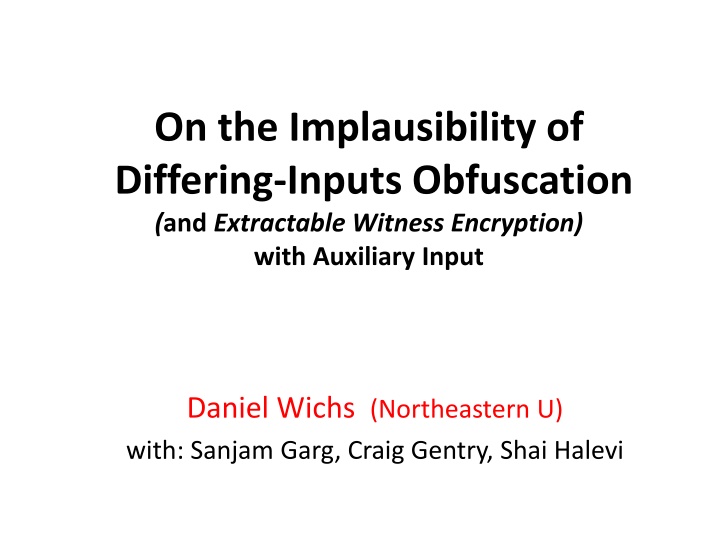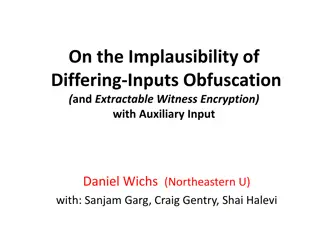
Obfuscation and Encryption Study by Daniel Wichs
Explore the research on the implausibility of differing-inputs obfuscation and extractable witness encryption with auxiliary input by Daniel Wichs from Northeastern University, along with Sanjam Garg, Craig Gentry, and Shai Halevi. Delve into the history of obfuscation, the challenges, and potential breakthroughs in the field.
Download Presentation

Please find below an Image/Link to download the presentation.
The content on the website is provided AS IS for your information and personal use only. It may not be sold, licensed, or shared on other websites without obtaining consent from the author. If you encounter any issues during the download, it is possible that the publisher has removed the file from their server.
You are allowed to download the files provided on this website for personal or commercial use, subject to the condition that they are used lawfully. All files are the property of their respective owners.
The content on the website is provided AS IS for your information and personal use only. It may not be sold, licensed, or shared on other websites without obtaining consent from the author.
E N D
Presentation Transcript
On the Implausibility of Differing-Inputs Obfuscation (and Extractable Witness Encryption) with Auxiliary Input Daniel Wichs (Northeastern U) with: Sanjam Garg, Craig Gentry, Shai Halevi
Overview of Result Differing-inputs obfuscation cannot exist assuming another form of obfuscation does exist. science philosophy / hand-waving + Theorems, Proofs What does it all mean?
Ancient History of Obfuscation 00-13 First formally studied by [Hada 00] and [Barak et al. 01]. Defined strong notion of virtual black-box obfuscation (VBB). Obfuscated code only as good as black-box access to program. Negative Result: VBB obfuscation is impossible for many pathological functions (contrived). Cannot have general VBB obfuscation. Don t have a general class that excludes all pathological functions . Positive Results: Can obfuscate some very simple functions like point functions [Canetti 97, Wee 05, ].
Our Knowledge of VBB Obfuscation unobfusctable obfusctable unknown
Interpretation of VBB before 13 unobfusctable obfusctable
Candidate Obfuscator The first general candidate obfuscator [Garg-Gentry-Halevi-Raykova-Sahai-Waters 13] Can be applied to any poly-time program. Fails to be VBB for some pathological functions , but does not seem to have any other weakness.
Interpretation of VBB after 13 unobfusctable obfusctable Green or red?
General Obfuscation Assumption Can we have a general, simple-to-state, useful assumption about an obfuscator? Two such candidates proposed by [Barak et al. 01]: Indistinguishability Obfuscation (iO) Differing-Inputs Obfuscation (diO)
Indistinguishability Obfuscation Definition (iO): An obfuscator Obf is secure if Obf(C) Obf(C ) for all circuits C, C such that C(x) = C (x) for all inputs x. Surprisingly powerful [Garg et al 13, Sahai-Waters 13, ] can get: functional encryption, witness encryption, deniable encryption, succinct ZK, non-interactive multi-party key agreement, broadcast encryption Many reasonable properties we can t prove using iO alone. Often harder to use than seems necessary.
Differing-Inputs Obfuscation Definition (diO): An obfuscator Obf is secure if Obf(C) Obf(C ) for all differing-inputs distributions (C,C ) D s.t. given C, C hard to find x : C(x) C (x)
Differing-Inputs Obfuscation Definition (diO): An obfuscator Obf is secure if Obf(C), aux for all differing-inputs distributions (C,C , aux) D s.t. given C, C , aux hard to find x : C(x) C (x) Obf(C ), aux Example: C(x) = {Output 0} C (x) = {Output 1 iff f(x)=y} f is a OWF, y f( $ ). Auxiliary input aux=y.
Differing-Inputs Obfuscation Recently explored by Ananth et al. [ABG+13] and Boyle et al. [BCP14] who showed many applications: obfuscation for TMs adaptively secure functional encryption for TMs. extractable witness encryption Many results using iO can be simplified if we use diO.
Our Results Show a distribution (C,C , aux) D such that can distinguish ( Obf(C), aux ) and ( Obf(C ), aux ) (extractable witness encryption) General differing-inputs obfuscation cannot exist assuming that a special-purpose obfuscation assumption holds (a specific function can be obfuscated to hide specific info) Under this assumption, D is a differing inputs distribution: given C,C , aux hard to find x s.t. C(x) C (x)
Counter-Example Want: distribution (C,C , aux) D 1. can distinguish ( Obf(C), aux ) and ( Obf(C ), aux ) 2. given C,C , aux hard to find x s.t. C(x) C (x) gets 1-bit of arbitrary leakage on signature ??. Attacker chooses many distinct messages mi, C(x): { Output 0 } C (x): { Output 1 iff x = (m,?) : ? is signature of m under vk } Cannot come up with any valid message/signature pair. Auxiliary info: C*(C) = { Set m := H(C), ?:= Signsk(m). Output C(m,?).} aux = O(C*) obfuscation of C*. Special-purpose obfuscation assumption : Given O(C*) and vk hard to find any valid msg/sig pair (m,?). Holds given black-box access to C* and vk.
At most one can survive! General differing-inputs obfuscation for all differing-inputs distributions [indistinguishability property] holds without having a candidate Not falsifiable [Naor 03 ] implies existence of efficient algorithm vs. Special-purpose obfuscation assumption given obfuscation of specific C* hard to recover a valid signature falsifiable
What to think of diO? General diO for all differing-inputs families is implausible. But diO and even VBB obfuscation can plausibly hold for most natural candidates that we d like to obfuscate. Better to rely on diO vs. VBB. Clarifies which property you really need. The search continues for a useful, plausible, general obfuscation assumption. Obfuscation is the new random oracle model ?


